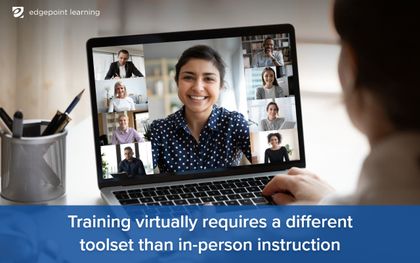15 Best Practices And Virtual Training Tips For Trainers
Corey Bleich
🍿 6 min. read
There is a definite art to delivering engaging, effective training online
Classes, courses, and training opportunities have flocked to online spaces in the last few years. Many companies are discovering that these can be just as effective as IRL offerings (if not more than). But there is a definite art to delivering engaging, effective training online. Whether your company has moved towards remote workers or just wants more options for training, here are 15 virtual training tips for trainers to support folks as they transition from the classroom to the screen.
What skills do virtual trainers need?
It might seem like virtual training is simply a matter of uploading all of your training materials online and hosting a Zoom meeting to discuss the concepts, but instructor-led virtual training is so much more than that. Not only do virtual trainers need to understand all of the course content, but they also need to be able to deliver it in an engaging way using technology that may not always cooperate.
Additionally, because training is delivered through a screen (instead of with the energy of an in-person experience) the trainer needs to bring an extra measure of enthusiasm and ability to connect virtually.
Put as simply as possible, training virtually requires a different toolset than in-person instruction.

10 of the best virtual training best practices
Virtual training tips for trainers have to be based in best practices for virtual instruction. Here are ten of our favorites to start with as you ramp up your instructors.
1. Practice proper preparation
Effective virtual training methods and techniques start with the same first step as training IRL: preparation. But not all preparation is the same.
Just as with in-person training, virtual training best practices start with really knowing your content. The next step – unique to virtual training – is mastering the platform for delivery. It’s hard to deliver solid content when you can’t figure out how to flip from one slide to the next or walk a class through a simulation.
If possible, also think through the training material itself. Is it set up to be shared effectively virtually? Start with our tips for designing virtual instructor-led training here.
Action: Brush up on material in the course well before training begins. Get help if you’re using a new platform that you are not familiar with. Write up a series of how-tos for the most common issues you run into. And, if you can, make suggestions for fine-tuning the material to a virtual format.
2. Be ready for the inevitable complications
You know the content back and forth, you’re a master at the training platform – then disaster strikes. The platform crashes, your internet is glitchy, or the batteries in your headset die. Virtual training best practices build in a back-up plan when Murphy’s law strikes.
Action: Consider pain points in your training platform, and design back-up plans. And, then a few more. Think of how you'd manage everything from equipment breaking to internet issues to loud trucks in the background.
3. Don’t skimp on equipment
We can’t all operate on a Fortune 500 budget, but skimping on quality training equipment is actually less economical than investing in proper gear. Unfortunately, our training tips for corporate trainers are only as good as the equipment that is delivering the course. Thankfully, there are many new and affordable options to support your trainers.
Action: Make proper equipment for virtual trainers a priority in your company. If you need to upgrade a little at a time, develop a timeline for all trainers to have high-quality gear, including webcams, headsets, laptops, software, and other peripherals they'll need. Depending on the scope, this may include light-boxes or multiple cameras for different angles.
4. Consider pre-session activities
Whether you are upskilling, onboarding, or offering a refresh, consider pre-session activities for your employees to “prime the pump.” This engages participants before they enter the virtual classroom and gets them ready to learn.
Action: Send out a short video tutorial on using the eLearning platform. Have participants complete a poll about their comfort with the material and their goals for the course, too.
5. Be “in the classroom" to greet participants
Consider yourself as the teacher standing at the classroom door, greeting students as they enter. Just as this IRL warm welcome helps students to feel more engaged in class, so too, does an online welcome make a big difference in how the class flows.
Action: Log in ten to 15 minutes early for any synchronous sessions. Use this time to answer questions about course content or chat and check in on students.
6. Build in participant engagement
The strange world of online lecture – including Zoom, Skype, and FaceTime – means that we don’t get the connection of eye contact. This could lead trainers to lecture, rather than trying to engage participants.
Simply asking “Any questions?” at the end of a 45-minute lecture isn’t effective.
Action: Look at your class plan and see where participants can break into groups for discussion. Regularly ask open-ended questions to check for understanding and application.
7. Set expectations
Some participants are old hands at online learning. Others are entering this space for the first time in their careers. Set your training up for success by outlining the shared expectations for your time together.
Action: Consider the following when setting expectations:
- Participant cameras off or on?
- Chat enabled?
- Participants muted? (We recommend yes with groups over five)
- Will you host any break-out rooms?
8. Avoid the tendency to lecture
Again, it’s easy to get into the trap of simply delivering material via lecture. Do this and watch your participants’ eyes glaze over.
Action: As much as possible, keep your camera turned on instead of just sharing your screen and reading what’s there. You might also use a timer that vibrates to remind you to stop and ask for questions or to encourage participant discussion.
9. Test drive sessions
You may have great ideas. Your platform might be engaging and easy-to-use. But make no mistake – once class starts there is going to be a lot happening at once.
Action: Test drive a class session (without students) to get a good idea of the flow, rate, and pace of your planned activities and to troubleshoot any speed bumps you encounter.
10. Ask for feedback
One of the virtual training tips for trainers that can be hard to follow through with is asking for feedback and evaluation after each session. But it’s crucial to make sure your trainings are effective.
Action: Use a survey to gather anonymous feedback to make your virtual trainings even better.

5 creative virtual training ideas to try
Effective virtual training methods and techniques combine the best practices above with creative ideas that engage a variety of learners.
Here’s five ways to get participants involved and excited with your virtual class.
1. Offer different modes of instruction
Mix it up to keep participants on their toes. Material can be delivered or supported in many different ways, including:
- Video
- Slides
- Musical interludes
- Breakout rooms
- Short essays
- Microlearning
- Short quizzes
- Polls
- Q&A breaks
2. Embrace AR
Augmented reality is a unique tool that offers “hands-on” training – even at a distance. This tool is great for safety training, onboarding, checking on product or sales knowledge, and many other applications.
In the virtual environment, consider how you can use AR to support what participants learn in the class. Give them AR-driven assignments so they can test-drive the skills they learned.
3. Use branching scenarios
Branching scenarios are the “choose your own adventure” setting of creative virtual training ideas. This offers participants a problem to solve or a task to perform with a variety of options.
Dealing with a customer service issue or trying to diagnose a mechanical issue as a group are great uses of this type of learning.
4. Have participants become the trainers
In this “each one, teach one” technique, participants become experts in one aspect of the course material and share it with everyone.
This benefits from up-front expectations and a clear system to keep organized. Otherwise, encourage creativity!
5. Build a mystery
Start with a case scenario and give participants some of the basic facts. Have them work together in small breakout groups to use what they know to figure out how the story ends.
Reconvene to compare notes before revealing what actually happened. Use this as a way to encourage both small and large group discussions.
Get virtual
Looking for more virtual training tips for trainers, or need some help putting these best practices into action? EdgePoint Learning can help.
Whether you need initial consulting and planning services, co-development help, or custom training from the ground up, we’re here. Get in touch to get started!
